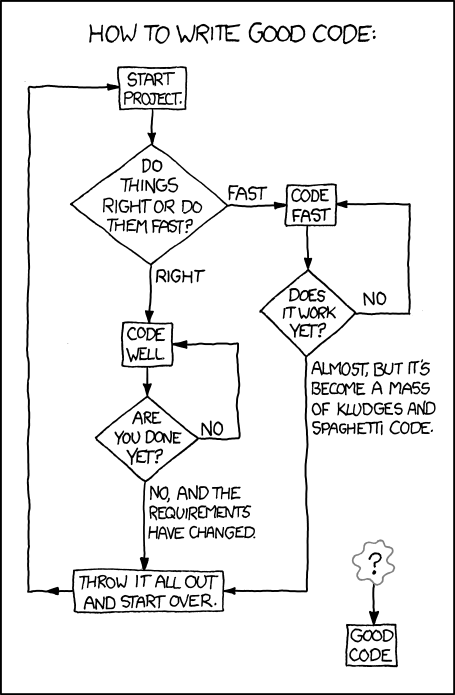Introduction
Welcome to the Steer Coding Best Practices Guide! Whether you're completely new to coding or a seasoned pro, this guide is intended to provide information and resources that will help you and your Steer colleagues to write better, more consistent code and to collaborate more effectively on coding projects.
This guide is intended to complement the ongoing Coding at Steer series of training sessions. Past sessions can be viewed here, and more sessions are on the way!
Context
As data sets get larger and are updated more frequently, some of our legacy tools are often being pushed to their limits. At the same time, our competitors have built up considerable programming skills, and we need to keep pace to stay relevant. Many at Steer have learned some programming elsewhere, whether in school, at a previous employer, or via self-directed learning, but until recently, there has been no consistent approach to developing coding skills or supporting those writing code at Steer.
This guide is part of a larger effort to develop a consistent approach to coding at Steer and to provide those who wish to learn the resources to do so. Besides, writing good code is hard (see the xkcd comic below), and we're hoping this effort will make it a bit smoother!

source: xkcd.com
Coding at Steer
At Steer, programming is used for the following three primary purposes:
- Data analysis: the processing of data, often involving synthesis of data from multiple sources. Common outputs include tabular data, visualizations, and inputs to travel models or other analyses.
- Local development: can range from small internal utilities to applications developed for use by external parties. Code is run on a laptop or workstation (and not on a server).
- Web development: development of browser-based applications, which can vary widely in scale. Involves server-side code that runs on a server and client-side code that is delivered to users and run in their browsers.
These use cases have much in common, but often require different tools and approaches. This guide attempts to address all of these use cases throughout, with most of the emphasis placed on data analysis and local development. If you're doing web development, be sure to check out the Steer Digital Guide for lots of great information.
Other Steer coding resources include the following:
- Coding at Steer Learning and Development training series
- Steer Coders on Teams (if you're not currently a member, but would like to join, please contact Andrew Desautels)
- Coding office hours (contact Andrew Desautels for more information)
Objectives
The specific objectives of this guide are to:
- Help you write better, more readable code.
- Help you minimize errors in your code.
- Encourage consistency in code style across Steer.
- Encourage creativity in your programming.
How to use this Guide
There is no single best way to use this guide, so feel free to read through the whole document, skim through reading only sections of interest, or use the search box to find information on specific topics.
Note the following:
- The guide focuses on high-level principles, and is written primarily for a beginner-level audience, though intermediate and advanced coders should find something useful.
- Where code samples are provided, Python, R, and JavaScript versions are included. In some cases where concepts are not language-specific, pseudocode is used.
- The guide is not intended to explicitly address coding within commercial travel demand modeling software, such as Cube and TransCAD, though most of the general best practices still apply.
Finally, treat the recommendations in this document as guidelines, not hard and fast rules. Coding is inherently creative, and once in a while you'll need to break the rules. This is expected and even encouraged!
About this Guide
This guide is intended to be a living document that will evolve over time to reflect changes in available/preferred tools and changes in the business needs of Steer. If you have any suggestions for improving the guide, please contact Andrew Desautels.
